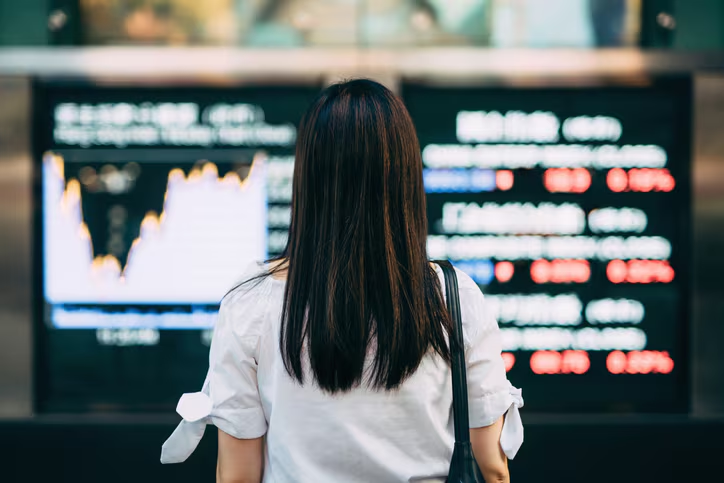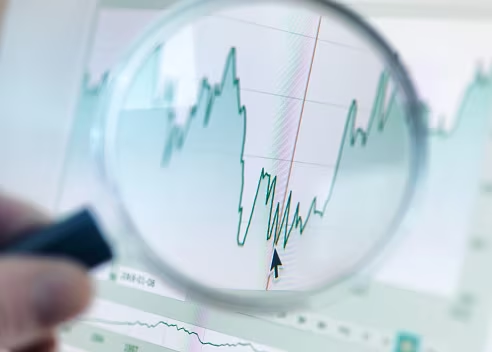Leverage is the use of a smaller amount of capital to gain exposure to larger trading positions, also known as margin trading. Leverage can be used across a variety of financial markets, such as forex, indices, stocks, commodities, treasuries and exchange-traded funds (ETFs). As an example, leveraged stock trading is an appealing choice for investors that don’t want to pay the full value of the share upfront or take ownership of the asset. In this article, we will explain what leverage is, how it's calculated and how you can use it to gain enhanced trading exposure across 11,000+ instruments on our trading platform.
- CFD Knowledge Hub
- Trading guides
- Leverage in trading: how does it work?
Leverage in trading: how does it work?

- 1.What is leverage in trading?
- 2.How does leverage trading work?
- 3.Example of leverage in stock trading
- 4.What are leveraged products?
- 5.Leverage ratios in the financial markets
- 6.Leverage ratio formula
- 7.How do you calculate leverage ratios?
- 8.Leverage trading platform
- 9.Risks of leverage
- 10.Leverage risk management
What is leverage in trading?
So, what does leverage mean? Leverage is the ratio applied to the margin amount to establish how big a trade is going to be placed. Understanding margin and leverage and the difference between the two can sometimes cause confusion. It is important to realise that margin is the amount of capital that is required to open a trade.
A leverage of 10:1 means that to open and maintain a position, the necessary margin required is one tenth of the transaction size. So, a trader would require $1,000 to enter a trade for $10,000. The margin amount refers to the percentage of the overall cost of the trade that is required to open the position. So, if a trader wanted to make a $10,000 trade on a financial asset that had a leverage of 10:1, the margin requirement would be $1,000.
Leverage can sound like a very appealing aspect of trading, as winnings can be immensely multiplied. But leverage is a double-edged sword – it is important to remember that losses can also be multiplied just as easily.
It is important for all traders to bear in mind the risks involved in leveraged trading. Many traders see their margin wiped out incredibly quickly because of a leverage that is too high. Novice traders should be especially careful when practicing margin trading. It is best to be more prudent and use a lower leverage. A lower leverage means that traders are less likely to wipe out all of their capital if they make mistakes.
How does leverage trading work?
To start trading on leverage, it is advisable that a trader starts with a leverage that is lower than their maximum leverage allowance. This enables traders to keep their positions open for the full size, even if they are experiencing negative returns.
Leveraged trading is more likely to be adopted by those trading short-term price movements. It would be much less suitable to anyone investing long-term, for example over multiple years or even decades. In this instance, a ‘buy and hold’ approach would be more suitable.
Example of leverage in stock trading
For example, let’s say a trader has a maximum leverage of 20:1 and opens a position on Apple shares with that leverage on a $10,000 account. The trader now has a position size with an asset value of $200,000, which has given them trading exposure to 20 times as many shares when compared with if they had purchased the assets outright without leveraging their starting capital of $10,000. To maintain this leveraged position in Apple stock, the value of the trader’s account would need to stay above the maintenance margin requirement of 50%, or 5,000 in this example.

What are leveraged products?
Leveraged products are derivative instruments that are worth more on the market than the deposit that was initially placed by an investor. A leveraged product that we offer is contracts for difference CFDs). When trading with leverage on CFDs, an investor can place a bet using a reasonably small margin on which way their chosen market will move. The investor technically does not own the underlying asset, but their profits or losses will correlate with the performance of the market.
CFD traders will have to pay a commission charge in addition to the spread when trading shares. To calculate your profits or losses, you must find the difference between the price at which you entered and the price at which you exited. For CFDs, it should be multiplied by the number of CFD units. Read more about our CFD commission rates here, along with our article on CFD meaning.
Leverage ratios in the financial markets
Leverage currency trading
Forex trading is the buying and selling of foreign currencies across the global market. Forex leverage ratios start relatively high compared to other markets at around 500:1, meaning that there is a high opportunity for profit or loss, depending on how you look at it.
Leverage for indices
Indices represent the overall price performance of a group of assets from a particular exchange. Commonly traded indices include the FTSE 100, S&P 500 and the Dow Jones 30. Indices tend to have quite low margin rates and therefore high leverage ratios of approximately 500:1.
Leveraged stock trading
Another market with a relatively low leverage ratio is share trading. Leverage ratios starts from 20:1 or a 5% margin rate for major international stocks such as Apple, Tesla and Amazon. This applies to the lowest tier of between 0-13,600 units. When you open a position above this amount, the margin rate will increase, subsequently decreasing the leverage ratio that you can trade with.
Cryptocurrency leverage trading
Bitcoin, ethereum and litecoin are all well-known cryptocurrencies across the globe. Cryptocurrencies are particularly volatile and can drop at any point; therefore, investors are advised to take caution when using leverage as part of their trading strategy, as this could lead to significant losses. Our maximum leverage ratio for trading cryptocurrencies is 20:1 (5%) on our CMC Next Generation platform and 6.6:1 (15% margin) for MT4, which is much lower than other financial markets, due to the substantial risks.
Leverage ratio formula
An important aspect in using leverage is understanding how to calculate the ratio. The following leverage ratio formula is commonly used and easy to remember:
L = A / E
where L is leverage, E is the margin amount (equity) and A is the asset amount.
Therefore, dividing the asset amount by the margin amount gives the ratio of leverage.
How do you calculate leverage ratios?
It is also possible to start with the margin amount and apply a leverage ratio to determine the position size. In this instance, the formula would be A = E.L. Therefore, multiplying the margin amount by the leverage ratio will give the asset size of a trader’s position.
Most traders distribute risks across different markets, meaning they are not putting all their capital into one trade. This is done by opening various positions in different markets. When this is the case, there may be the need to do calculations to determine net asset value or the accumulative value of a trader’s positions. Thanks to platform technology that most brokers will offer, it is easier to monitor all parameters, and open or close individual positions as needed. More importantly, it can help a trader work out if positions fit within their total leverage amounts, which should be less than the maximum leverage allowed by the broker.
Leverage trading platform
As discussed, we have differing leverage ratios and margin rates for each type of financial market and asset. All products are available on our trading platform, Next Generation, where you can put into place risk management tools, such as stop-loss and take profit orders. Familiarise yourself with our platform now by creating a live account, or practise first with virtual funds on a demo account, which is included for free upon registering. Take a look at our extensive list of charting features here.
Risks of leverage
The most important thing to understand when talking about leverage is the risk involved. Risk is inherent to any type of trading, however, leverage can cause both magnified profits and losses. It would be prudent for traders to pay particular attention to choosing how much leverage they will use. The leverage ratio should be determined in advance of trading. It is very tempting to trade in a larger size than what was originally determined if you have a streak of winning trades.
Doubling your risk on a one-off basis could benefit a trader if they happen to get that one-off trade right. But get it wrong and a trader could end up facing a much larger loss than usual. To help reduce risks in trading, you should plan out your trading strategy in advance.
Two factors could be taken into consideration when determining what amount of leverage to apply to a portfolio: how much risk to take per trade and how much risk to take per day. Examining this via percentages makes things easier. First, a trader can determine how much risk they are willing to take per day. This involves deciding the maximum amount that you are willing to lose. This could, for instance, be between 1% and 2%. If a trader were using 2% as maximum daily risk, it would take 50 days of bad losing trades in a row to wipe out their capital, which is hopefully extremely unlikely to happen.
A trader should also determine how many trades they want to place per day. This could be a set number or a maximum number. For example, a trader may decide that whatever the market, they will make a maximum of three trades a day. In each case, the trader can divide the percentage they are willing to risk per day by this number.
Leverage risk management
A popular risk-management tool to be considered when trading with leverage is a stop loss. By implementing a stop-loss order to your position, you can limit your losses if your chosen market moves in an unfavourable direction. For example, a trader may choose a pre-determined figure that they do not want to surpass, meaning that your stake in the instrument will be sold at the given price. However, please note that basic stop losses are susceptible to market gapping and slippage. Guaranteed stop losses work exactly in the same way as basic stop orders, although investors can choose to pay a small fee to guarantee the closing of a trade at the exact price specified. This way, if you have used a particularly high leverage in the trade, there will be less chance of multiplying your losses, regardless of market volatility.